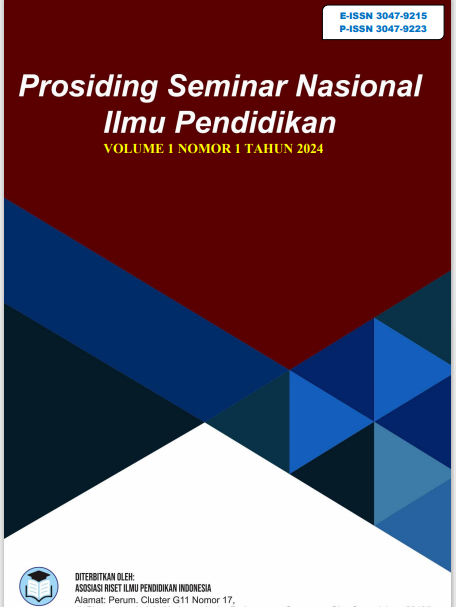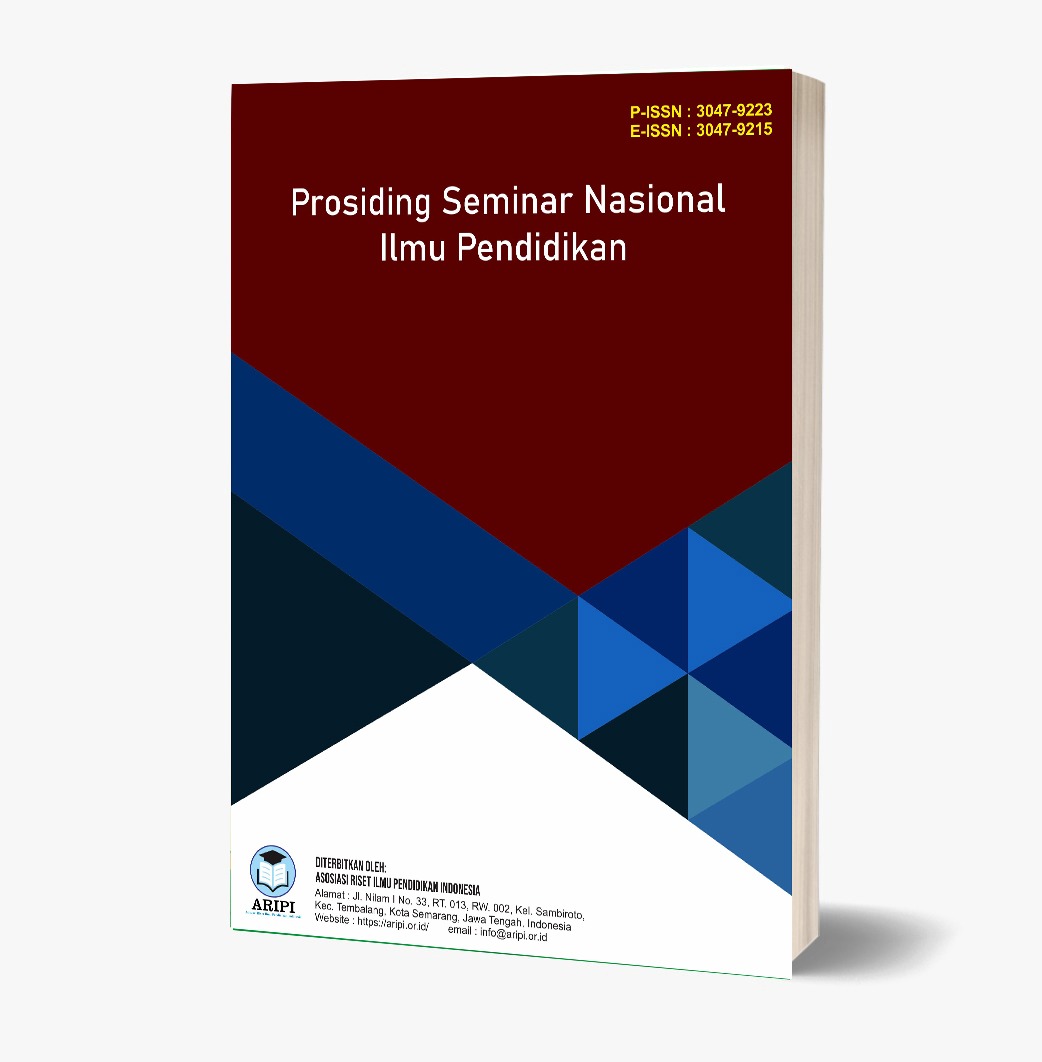Desain Berpikir: Pengaruh Penggunaan Model Pengajaran Berbasis Pemecahan Masalah Pada Pendidikan Inklusif
DOI:
https://doi.org/10.62951/prosemnasipi.v2i1.120Keywords:
Problem Solving, Inclusive Education, BibliometricsAbstract
Problem solving is a process that involves mental operations such as deduction, induction, classification, evaluation, and reasoning. This study aims to capture the landscape of problem solving research, particularly in secondary schools. The method used is bibliometric descriptive analysis. The source of the data obtained came from the Scopus database. 100 relevant documents were found, indicating the increasing but still limited interest of researchers in problem-solving skills in inclusive education. This research aims to direct future research and support the development of responsive and inclusive education policies.
References
Azzahra, S., & Dhona, H. R. (2023). Ekslusi anak berkebutuhan khusus di sekolah inklusi. Media Komunikasi FPIPS, 22(1), 46–58. https://doi.org/10.23887/mkfis.v22i1.56610
Baragash, R. S., Al-Samarraie, H., Alzahrani, A. I., & Alfarraj, O. (2020). Augmented reality in special education: A meta-analysis of single-subject design studies. European Journal of Special Needs Education, 35(3), 382–397. https://doi.org/10.1080/08856257.2019.1703548
Berkeley, S., Marshak, L., Mastropieri, M. A., & Scruggs, T. E. (2011). Improving student comprehension of social studies text: A self-questioning strategy for inclusive middle school classes. Remedial and Special Education, 32(2), 105–113. https://doi.org/10.1177/074193251036126
Blizzard, J., Klotz, L., Potvin, G., Hazari, Z., Cribbs, J., & Godwin, A. (2015). Using survey questions to identify and learn more about those who exhibit design thinking traits. Design Studies, 38, 92–110. https://doi.org/10.1016/J.DESTUD.2015.02.002
Brown, T. (2008). Design thinking. Harvard Business Review, 84–92. www.hbr.org
Carlgren, L., Rauth, I., & Elmquist, M. (2016). Framing design thinking: The concept in idea and enactment. Creativity and Innovation Management, 25(1), 38–57. https://doi.org/10.1111/caim.121
Cifuentes, S. C., García, S. G., Andrés-Sebastiá, M. P., Camba, J. D., & Contero, M. (2016, July). Augmented reality experiences in therapeutic pedagogy: A study with special needs students. In 2016 IEEE 16th International Conference on Advanced Learning Technologies (ICALT) (pp. 431–435). IEEE. https://doi.org/10.1109/ICALT.2016.23
Design Council. (2007). Eleven lessons: Managing design in eleven global companies. Desk research report. London. https://www.designcouncil.org.uk/sites/default/files/asset/document/ElevenLessons_DeskResearchReport_0.pdf
Fleury, A., Stabile, H., & Carvalho, M. (2016). An overview of the literature on design thinking: Trends and contributions. International Journal of Engineering Education, 32(4), 1704–1718.
Goldschmidt, G., & Rodgers, P. A. (2013). The design thinking approaches of three different groups of designers based on self-reports. Design Studies, 34(4), 454–471. https://doi.org/10.1016/J.DESTUD.2013.01.004
Hasso Plattner Institute of Design at Stanford University (d.school). (2010). (archival resource) Design thinking bootcamp bootleg. https://dschool.stanford.edu/resources/the-bootcamp-bootleg
Huang, R., Spector, J. M., & Yang, J. (2019). Design methodology. In Educational technology: A primer for the 21st century (pp. 189–228). Springer Singapore. https://doi.org/10.1007/978-981-13-6643-7_12
Ito, M., Naoe, N., Imazawa, A., & Matsushita, O. (2015). Introduction of adapting design thinking into the education in Kanazawa Technical College. In 2015 IEEE 7th International Conference on Engineering Education (ICEED) (pp. 25–28). IEEE. https://doi.org/10.1109/ICEED.2015.7451486
Johansson-Sköldberg, U., Woodilla, J., & Cetinkaya, M. (2013). Design thinking: Past, present and possible futures. Creativity and Innovation Management, 22(2), 121–146. https://doi.org/10.1111/caim.12023
Kelley, T., & Kelley, D. (2013). Creative confidence: Unleashing the creative potential within us all. Currency.
Kimbell, L. (2011). Rethinking design thinking: Part I. Design and Culture, 3(3), 285–306. https://doi.org/10.2752/175470811X13071166525216
Kou, G., Yüksel, S., & Dinçer, H. (2022). Inventive problem-solving map of innovative carbon emission strategies for solar energy-based transportation investment projects. Applied Energy, 311, 118680. https://doi.org/10.1016/j.apenergy.2022.118680
Lintner, T., & Kumpiene, G. (2017). Social studies instruction for students with mild disabilities: An (updated) progress report. The Journal of Social Studies Research, 41(4), 303–310. https://doi.org/10.1016/j.jssr.2017.03.003
Lugmayr, A., Stockleben, B., Zou, Y., Anzenhofer, S., & Jalonen, M. (2014). Applying “design thinking” in the context of media management education. Multimedia Tools and Applications, 71(1), 119–157. https://doi.org/10.1007/s11042-013-1361-8
Luka, I. (2020). Design thinking in pedagogy. Journal of Education Culture and Society, 5(2), 63–74. https://doi.org/10.15503/jecs20142.63.74
Pande, M., & Bharathi, S. V. (2020). Theoretical foundations of design thinking – A constructivism learning approach to design thinking. Thinking Skills and Creativity, 36, 100637. https://doi.org/10.1016/j.tsc.2020.100637
Patel, S., & Mehta, K. (2017). Systems, design, and entrepreneurial thinking: Comparative frameworks. Systemic Practice and Action Research, 30(5), 515–533. https://doi.org/10.1007/s11213-016-9404
Pazim, K. H. (2021). Special education teachers job satisfaction in Malaysia: A review. Turkish Journal of Computer and Mathematics Education (TURCOMAT), 12(11), 5329–5332. https://doi.org/10.17762/turcomat.v12i11.6758
Razzouk, R., & Shute, V. (2012). What is design thinking and why is it important? Review of Educational Research, 82(3), 330–348. https://doi.org/10.3102/0034654312457429
Ross, E. W., Mathison, S., & Vinson, K. D. (2014). Social studies curriculum and teaching in the era of standardization. In The social studies curriculum: Purposes, problems, and possibilities (pp. 25–49).
Scheer, A., Noweski, C., & Meinel, C. (2012). Transforming constructivist learning into action: Design thinking in education. Design and Technology Education: an International Journal, 17(3). https://ojs.lboro.ac.uk/DATE/article/view/1758
Steele, M. M. (2007). Teaching social studies to high school students with learning problems. The Social Studies, 98(2), 59–63. https://doi.org/10.3200/TSSS.98.2.59-64
United Nations. (2006). Convention on the rights of persons with disabilities. United Nations.
Wrigley, C., & Straker, K. (2015). Design thinking pedagogy: The educational design ladder. Innovations in Education and Teaching International, 54(4), 374–385. https://doi.org/10.1080/14703297.2015.1108214
Downloads
Published
How to Cite
Issue
Section
License
Copyright (c) 2025 Prosiding Seminar Nasional Ilmu Pendidikan

This work is licensed under a Creative Commons Attribution-ShareAlike 4.0 International License.







